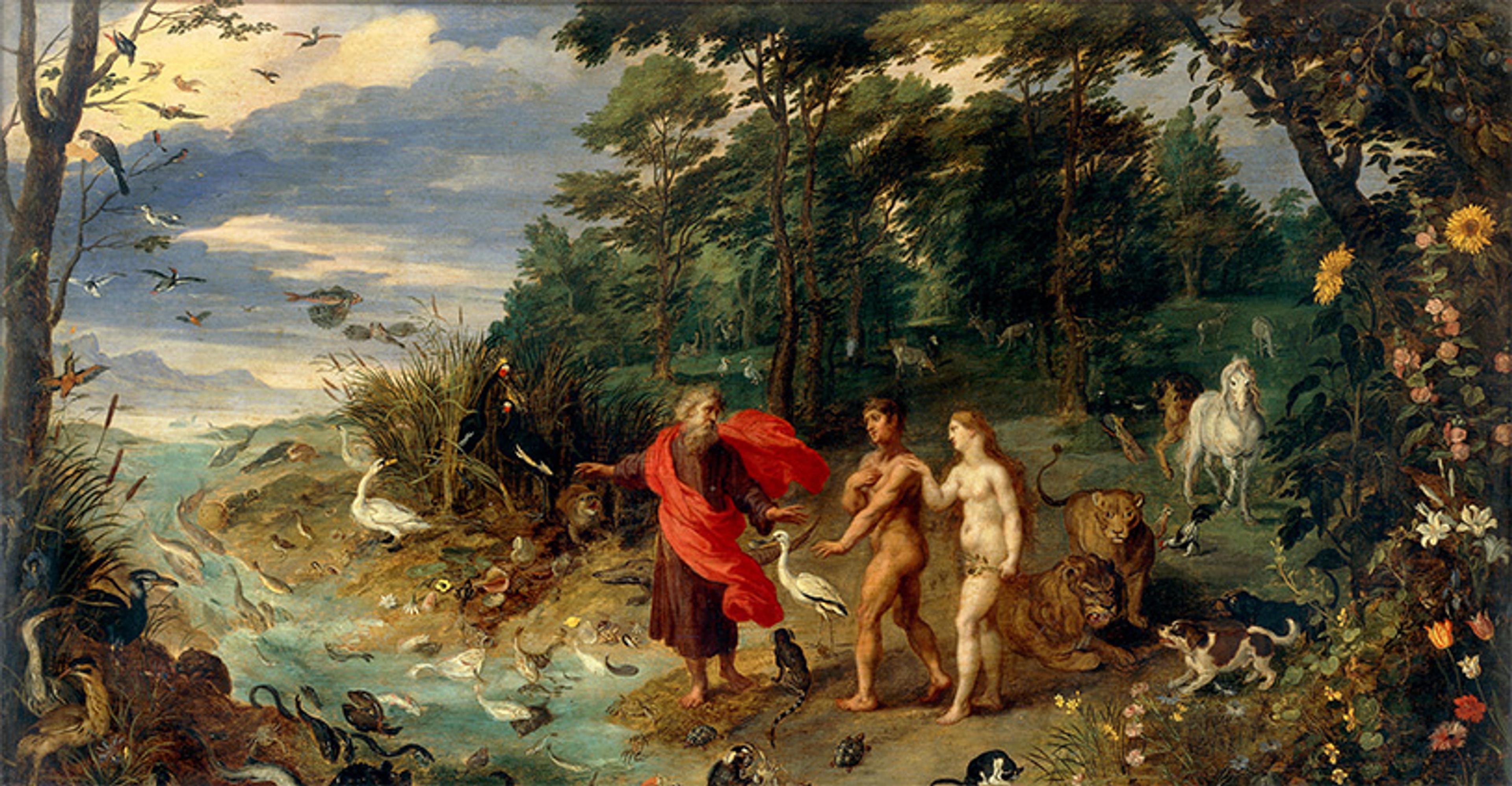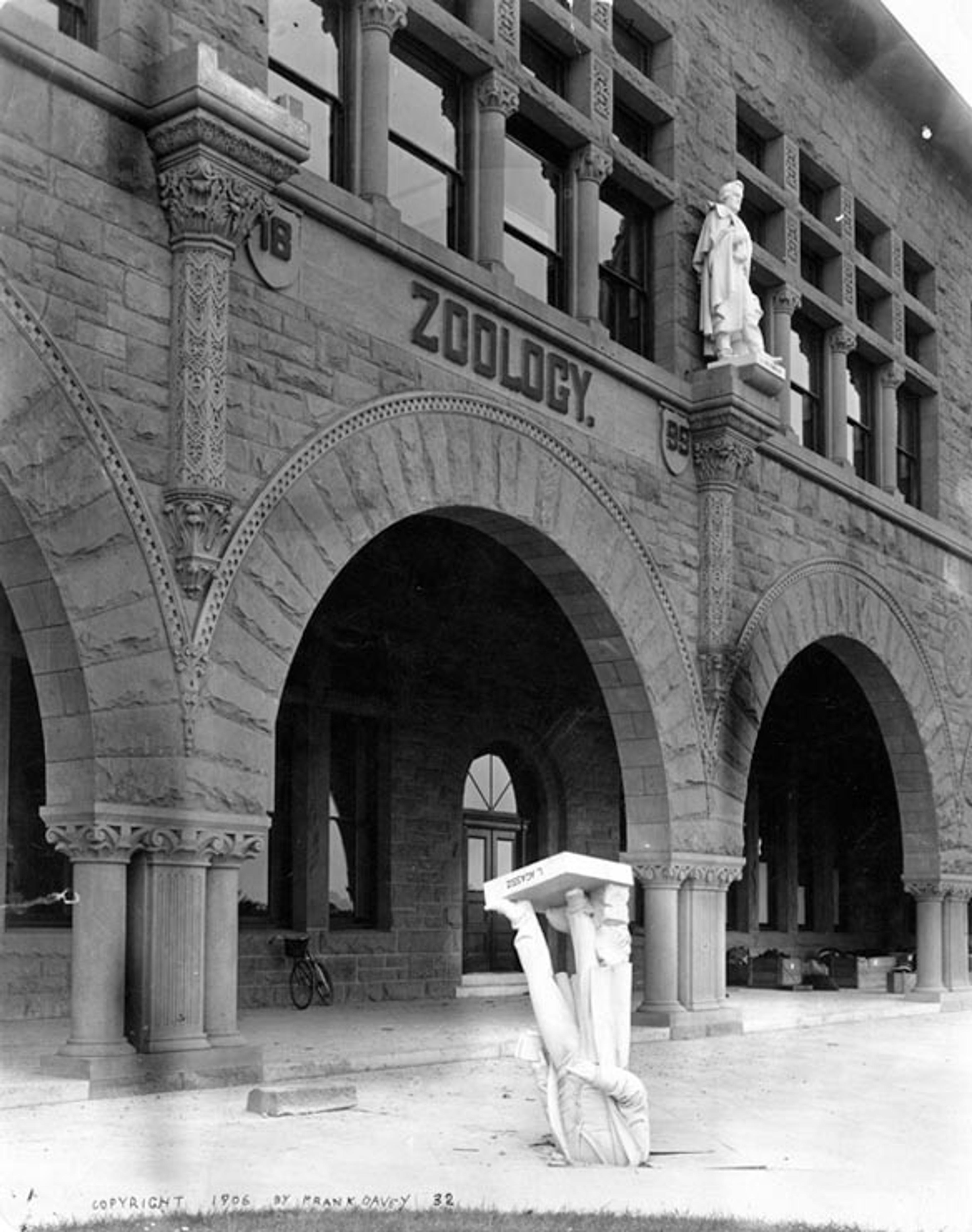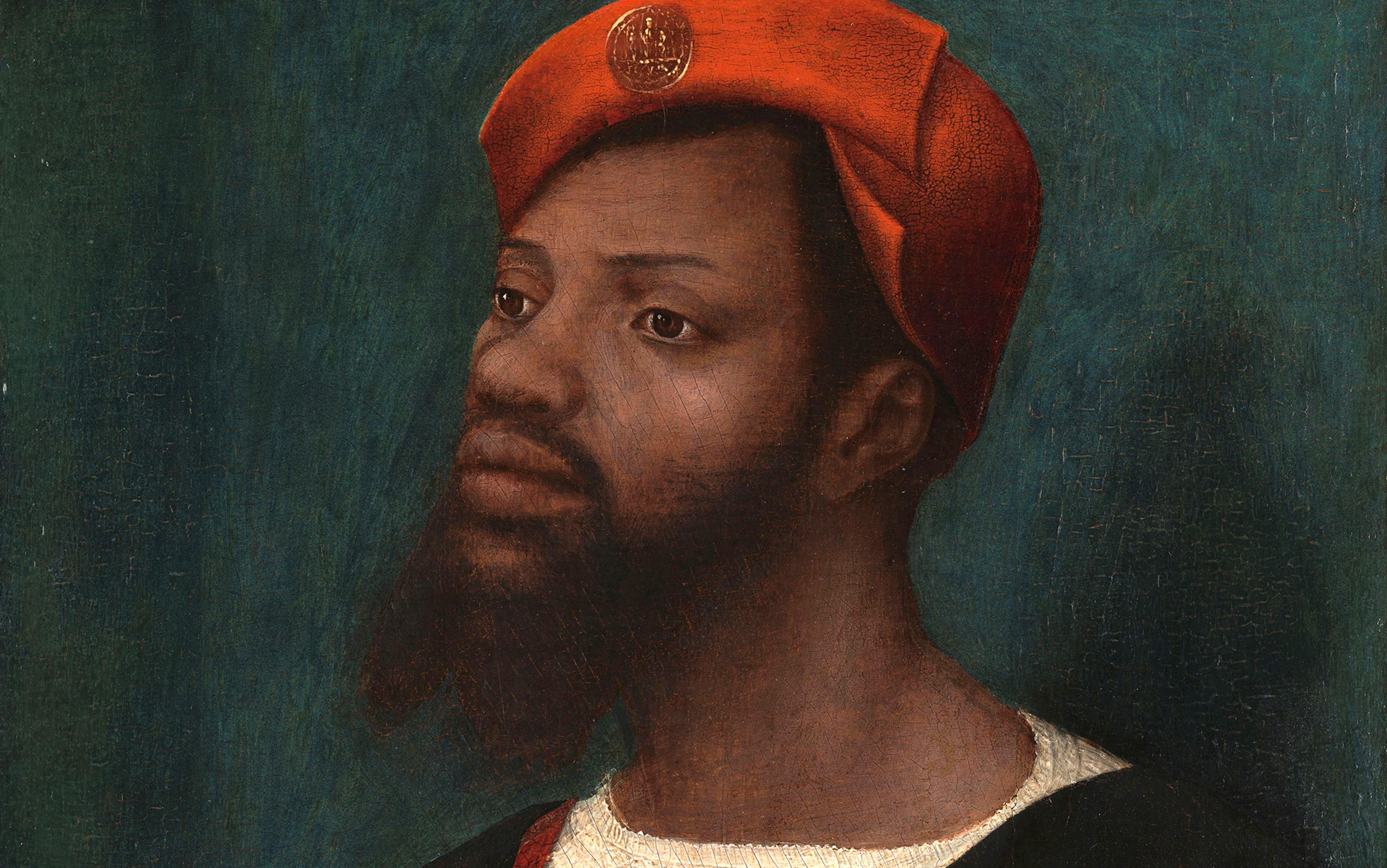Imagine for a moment that tomorrow we find humans on another planet. It’s an unlikely scenario to be sure, but you can imagine the theories that people might venture to explain their existence. They might propose that humans on this other planet descended from ancient earthlings who in prehistoric times had the technology to travel there. Or that humans on both planets were planted there by aliens. Or that conditions on the other planet are so similar to those found on Earth that humans evolved on both planets simultaneously. Then again, perhaps God created humans on both planets.
A very similar problem confronted the European mind in the modern period (though the analogy is not perfect). As Europeans embarked on great voyages of discovery from the 15th through to the 19th centuries, they were at a loss to explain how the native peoples they encountered in distant lands actually got there. Europeans generally assumed that all people descended from Adam and Eve – a view called monogenism – and so it was unclear how native humans came to exist in ‘New Worlds’ oceans apart from the original Garden of Eden. What is more, non-Europeans looked and acted differently. Before Charles Darwin, and for some time after him, there was no generally accepted explanation of these physical and cultural differences.
The challenge for early moderns, then, was to find a plausible explanation for how physical differences between humans arose if all humans on Earth descended from Adam and Eve. Some thinkers, such as the German naturalist Johann Friedrich Blumenbach (1752-1840), thought that human diversity arose through ‘degeneration’ from the original humans, where degeneration is caused by environmental features such as what your ancestors ate or the climate they inhabited.

Adam and Eve in the Garden of Eden (c1640) by Jan Brueghel the Younger. Courtesy the Ambrosiana Library, Milan
A more radical way to explain human diversity involved accepting polygenism – the view that God originally created multiple first human mating pairs besides Adam and Eve. In the hypothetical scenario above, polygenism is akin to thinking that God created humans on both planets. As it happens, many influential 19th-century scientists in the United States were polygenists, turning to the theory as a means of explaining human racial differences – differences that were front and centre in American life. Proponents of polygenism argued that racial differences were fixed, some of them recruiting the theory to justify enslaving peoples whom God had made ‘lesser’.
Scientists like Samuel George Morton (1799-1851), who has been called the father of American anthropology, and the Swiss-born biologist and geologist Louis Agassiz (1807-73), a professor at Harvard, used polygenism as a purportedly scientific tool to help explain racial difference. Agassiz claimed that ‘the differences existing between the races of men are of the same kind as the differences observed between the different families, genera, and species of monkeys or other animals …’ On this view, different races have different physical attributes that correspond to intellectual and moral characteristics (that is, normative properties). Hence, for Agassiz there is a hierarchy of races, with whites superior to all others. Agassiz’s view that racial differences were built into the fabric of nature by God carried weight with the scientific establishment, and convinced many Harvard graduates that intelligence and moral goodness were racially determined.
Agassiz and others used polygenism to boost scientific support for slavery, to the extent that, as the anthropologist Charles Loring Brace points out in ‘Race’ is a Four-Letter Word (2004), their advocacy became a contributing factor to the American Civil War. Since polygenists understood races as different species, many, like Josiah Nott, a follower of Morton, believed inter-racial reproduction would yield less fertile offspring, just as breeding between horses and donkeys leads to mostly infertile mules. Nott’s article in The Boston Medical and Surgical Journal bore the telling title: ‘The Mulatto a Hybrid – Probable Extermination of the Two Races if Whites and Blacks are Allowed to Intermarry’ (1843). Such belief in a fundamental distinction between the races underscored anti-miscegenation laws that were widespread in the US. In 1869, the Georgia Supreme Court wrote:
The amalgamation of the races is not only unnatural, but is always productive of deplorable results. Our daily observation shows us, that the off-spring of these unnatural connections are generally sickly and effeminate, and that they are inferior in physical development and strength, to the full-blood of either race.
Polygenic ideas with a distinctly racist cast persisted through the 20th century, with figures like Carleton Coon, a professor both at the University of Pennsylvania and at Harvard, arguing in his influential The Origin of Races (1962) that the races evolved into Homo sapiens at different times. He maintained that the white race was more advanced on account of having evolved into H sapiens first. All in all, polygenism has been hugely influential in American scientific racism and its fallout. Indeed, you cannot fully understand American racism without understanding polygenism and its history. So how did polygenism first gain traction? And how did it become a mainstream view among the American scientific establishment?
The racial science of the 19th century had deeper origins in the 17th century that are mostly unknown today. In fact, polygenism was one of the more controversial ideas of the 17th century. It appealed to early modern European thinkers because it helped explain the existence of Indigenous peoples in far-flung lands, which monogenesis struggled to encompass. To help fend off polygenism, the Dutch humanist philosopher and monogenist Hugo Grotius proposed in 1642 that Native Americans were descendants of Norwegians who had moved to Iceland, then to Greenland, and then to North America. Later adherents of monogenism include Immanuel Kant, Blumenbach and Darwin.
The first intellectual to substantially defend polygenism was the French lawyer and theologian Isaac de La Peyrère (1596-1676). He published two works in 1655 – Men Before Adam and Theological Systeme upon the Presupposition, That Men Were Before Adam – that sparked immediate public fascination. La Peyrère recognised that Genesis contains two creation accounts in the first two chapters, and cited this as evidence that the Bible itself teaches that God created ‘pre-Adamites’ who were distributed throughout Earth (according to Genesis 1) before creating Adam and Eve. Through creative interpretation of Genesis 1, La Peyrère argued that all plants and wildlife were created for humans; and on this basis, he concluded that wherever plants and livestock were created, so humans were created as well. In La Peyrère’s scheme of prehistory, not only were pre-Adamite humans created before Adam, they were also distributed as mating pairs throughout the world. Looking elsewhere to support polygenism, La Peyrère noted that, after Cain is cast out of Eden for killing Abel, he says: ‘Whosoever finds me, shall slay me,’ which suggests that other people already existed. Cain is also said to have had a wife, despite Adam and Eve not having had a daughter. One of La Peyrère’s lasting contributions was his insistence that Adam and Eve are not the first human beings.
La Peyrère’s interpretation reduced Genesis from a global history of humanity to a history of the Jewish people
La Peyrère further drew on a passage from Paul’s letter to the Romans, which suggests that sin in the world predates Adam and Eve. La Peyrère takes this to mean there must have been sinners, and therefore people, before Adam. By way of dispatching the Biblical claim that ‘God made all mankind of one blood’ – some ancient variations say ‘from one ancestor’ – La Peyrère reads it as saying that all humans are children of God and not descendants of Adam.
As well as accounting for Indigenous peoples, La Peyrère was concerned to reconcile Christianity with those non-Biblical histories that appeared to conflict with the timeline of Genesis. The predominant view in the 17th century, based on a literal reading of Genesis, was that the creation of the world occurred at roughly 2348 BCE, making Earth only about 4,000 years old, while Chaldean and Egyptian creation accounts cite the creation of humans much farther back. Where most Europeans would have rejected non-Biblical creation stories, La Peyrère argued that they are in fact consistent with Genesis, because Genesis does not account for all human origins. La Peyrère’s interpretation thus reduced Genesis from a global history of humanity to a history of, primarily, the Jewish people. Genesis primarily concerns the creation of Adam and Eve, despite offering clues about the creation of other humans – its two creation accounts; the claims about Cain. For the beginnings of non-Jewish peoples, La Peyrère looked to Babylonian, Egyptian, Chinese and American creation narratives.
To La Peyrère’s critics, his attempts to reconcile faith and reason looked revisionary and heretical. Dozens of books were quickly written to rebut him. According to the historian of philosophy Richard Popkin writing in 1987, polygenism was the most energetically refuted idea of the 17th century – indeed, under sustained assault, La Peyrère was eventually forced by the Catholic Church to recant his views.
Although polygenism offered a Biblical explanation of human diversity, it challenged the fundamental unity of humanity. La Peyrère went beyond explaining why Indigenous peoples existed in far-off lands to theorise ontological differences in ‘genus’ and ‘species’ between pre-Adamites, whom he also called the ‘Gentiles’, and Adamites, whom he called the ‘Jews’. As he put it: ‘not onely by kindred, and exposition of kindred did God distinguish the Jews from the Gentiles but would have them different in the species it self.’ In La Peyrère’s usage, a ‘genus’ distinction denotes a difference in family lineage. Pre-Adamites and Adamites are different in genus because they issue from different original ancestors. Given that pre-Adamites descend from ‘innumerable fathers’, there are also genus distinctions within the pre-Adamites.
A ‘species’ distinction is a bit more complicated. It is here that the notion of hierarchy comes into La Peyrère’s account, making it a progenitor of racialism in later polygenetic theories. According to La Peyrère, a species distinction amounts to a difference in the form or essence of a human, which arises in part from the mode of creation and material composition of each type of human. In a rather creative reading of Genesis, La Peyrère claims that the Adamites were made by God through a unique mode of creation – God used his hands to form Adam – whereas the early humans who preceded Adamites were made with God’s ‘word’ – God spoke them into existence – just as all other creation was made. In other words, the two species were made through different modes of creation, and the mode used to create the pre-Adamites was not unique to them. Adamites are not just uniquely made, according to La Peyrère, they are also made of a superior, more refined material than the primal matter from which pre-Adamites are composed. Though the material used to make both species is faulty, the primitive matter of pre-Adamites is more faulty. The mode of creation and material inferiority of pre-Adamites is evidence to La Peyrère that they have a form that ranks below Adamites but above nonhuman creatures.
La Peyrère did not have the broad conception of the human species that we have today, based on later archaeological findings that offer evidence of hominin species besides Homo sapiens, such as H erectus or H habilis. But he did have a concept of hierarchy. Pre-Adamites, he argued, are made in the internal image of God, while Adamites are made in the external image of God. As a result of this superiority, the Adamite people have ‘a lesse corrupt nature’ and are less prone to sin than pre-Adamites. In contrast, the essence of pre-Adamite people is less perfect, giving them a greater disposition for vice. From the essence of each species stems their normative properties.
Though hierarchical, La Peyrère’s understanding of a species doesn’t equate with our conception of race in the modern sense because his grouping of human species is not based on phenotypic features like skin colour. But should we view his account of human difference as racialist (that is, racist) nonetheless? Racialism is the view that human groups possess an underlying biological essence, expressed both in the distinctive physical features and normative properties of that group, such as their intelligence or moral goodness. Racialism also ranks races as inferior or superior based on their normative features. Most scholars would say that polygenism is racialist in its later 18th- and 19th-century forms, but not in La Peyrère’s system. In my view, however, the species distinction that La Peyrère elaborates is hierarchical and embodies many of racialism’s features: it is biological in its concern with the material of human bodies, and essentialist because it proposes unalterable underlying group essences, then assigns normative properties based on those underlying essences.
Blumenbach suggested degeneration from whiteness was caused by external factors such as climate
Because La Peyrère’s polygenism does not distinguish between human species on the basis of phenotypic features, his view is what I’d call ‘proto-racialist’. He adopts all the features of racialism except for this notion that biological human essences are expressed in phenotypical features, like skin colour. The French physician François Bernier is often credited with being the first thinker to categorise humans into modern races, leaning on features, such as skin colour, that correlate with geographical locations. But Bernier published his views in his essay ‘A New Division of the Earth’ (1684), 29 years after La Peyrère published his Theological Systeme.
Picking up on Bernier’s distinction, the Swedish biologist Carl Linnaeus (1707-78) classified human beings into four groups: Homo sapiens europaeus (Europeans), H sapiens asiaticus (Asians), H sapiens americanus (Americans), and H sapiens afer (Africans). Linnaeus began the tradition of classifying organisms by generic (genus) and specific (species) names. In the late 18th century, Blumenbach adopted Linnaeus’s classification, but split the Asian variety into Mongolian and Malay for a total of five groups. One of Blumenbach’s enduring contributions is his use of the term ‘Caucasian’ to refer to people of European descent. For him, races emerged via a process of ‘degeneration’ from the original humans, Adam and Eve, who were from the Caucasus region east of the Black Sea. Blumenbach suggested that degeneration from whiteness was caused by external factors such as climate or nutrition. On this account, human racial categories are changeable because they are prone to external influence and ‘differ from each other in degree’.
Contra Blumenbach, polygenists generally understood human types and their associated normative properties to be unalterable. This fixity of normative properties could be co-opted into supporting social institutions of subjugation. As early as 1680, the Anglican colonial writer Morgan Godwyn noted in his book The Negro’s and Indians Advocate that polygenism was being used to argue that some groups of people were inferior to others, and to justify slavery. From its birth in the 17th century, La Peyrère’s polygenism was gradually unmoored from a distinction between pre-Adamite and Adamite species, and reframed to support the separate origins of the five or so races that thinkers like Bernier and Blumenbach theorised. Though already essentialist in La Peyrère’s system – since it proposed unalterable group characteristics – polygenism became a way to essentialise phenotypic differences between human groups, as expressions of underlying human essences fixed since the creation of the world.
One of the most important figures in American anthropology in the 19th century was Samuel George Morton. He adopted Blumenbach’s five varieties of humans and explicitly labelled them ‘races’. However, as a young-Earth creationist who believed our planet to be roughly 4,000 years old, he did not adopt Blumenbach’s (and others’) ideas about degeneration. On such a short timescale, Morton thought, degeneration could not have produced the diversity among humans we see today. Instead, he drew on polygenism to claim that human races were ‘primeval diversities among men’ that began at creation.
Morton went further than Blumenbach in ascribing essential natures to different races. He used skull measurements to argue for fundamental biological divergence. By filling skulls with gunpowder to measure their volume and using numerous other measurements, Morton argued that races can be empirically classified into 22 ‘families’ distributed across the five races. Morton’s followers, such as George Gliddon and Josiah Nott, took skull measurements as proof that Black and white people had different original ancestors, and that Black people did not descend from Adam and Eve. For Nott, the races were separate species ‘marked by peculiarities of structure, which have always been constant and undeviating.’ Among those peculiarities, the supposedly larger skull size of whites argued for their normative superiority, while the smaller cranial volume in Africans meant that ‘the intellectual portion of the brain is defective’.
Agassiz claimed there are no passages in the Bible asserting that Adam and Eve were the first humans
Some 19th-century American thinkers explicitly cite La Peyrère. A summary of his thinking by a so-called ‘Philalethes’ appears in The Anthropological Review in 1864:
After two centuries of neglect and oblivion, the name of Isaac de La Peyrère is once more received and honoured, as that of the first scholar who broke through the meshes of groundless traditional prejudice, and proved that even in Scripture there are no decisive evidences of man’s descent from a single pair; nay more, that there are distinct indications of non-Adamite races.
Nathaniel Langdon Frothingham, a Unitarian minister and fellow of the American Academy of Arts and Sciences, suggested a comparison between La Peyrère and Galileo in 1851 – both were intellectual heroes persecuted by the Church. However, there were significant methodological differences between the Anglo-American scientists and their 17th-century predecessor: 19th-century anthropologists were ostensibly concerned with empirical evidence, whereas La Peyrère primarily drew on Biblical support. But since La Peyrère’s theology was largely perceived as heretical, it would have disinclined the orthodox in Christian America.
However, figures like Nott and Agassiz did enter the fray of Biblical interpretation. Nott questioned the historical accuracy of Genesis. And Agassiz claimed that there are no passages in the Hebrew Bible asserting that Adam and Eve were the first humans. Agassiz also took an interpretive line that echoed La Peyrère’s. Despite advocating for a hierarchy of human races, he wrote that each race is ‘equal before God’ and he embraced different races as ‘brethren in humanity’. La Peyrère had likewise maintained that all humans are children of God, even while claiming that different species of humans are made in different images of God.
In sum, La Peyrère provided a polygenetic framework that was renovated and defended on purportedly scientific grounds in the 19th century. Thinkers like Morton, Gliddon, Nott and Agassiz all reframed polygenism in essentialist terms, differentiating the races by phenotypic features, such as skin colour and skull size. In their view, polygenic theories explained normative properties, not least moral disposition and intelligence. Polygenism thus took on an explicitly racialist tone that leant itself to political factions keen to defend white supremacy, the subjugation of native Americans, and the enslavement of Black people.
Thinkers like Morton, Gliddon, Nott and Agassiz exerted an enormous influence on American attitudes to race. As Brace points out: ‘The concept of “race” that is now generally accepted throughout the world is the direct legacy of the polygenist winners of the debate that ran throughout the first half of the 19th century.’ Polygenism gives a clear explanation for why biological races are as essential as they are and unalterable: to wit, the races of humans were created by God as such and therefore have stable physical differences that correlate with normative properties. Polygenism allows for an especially essentialist notion of race. This essentialism was present in La Peyrère’s polygenism, so it’s puzzling that the respected historian of philosophy Richard Popkin saw his polygenism as ‘benign’.
As Darwin’s explanation of human diversity via natural selection emerged as a serious competitor to polygenism, the multiple-origin theory of humankind began to wane among scientists. The theory of evolution, paired with new evidence for a much older Earth, explained how a fully diverse human population could stem from a common ancestor, as monogenism claimed. Although polygenism fell out of favour, scientific racism did not. It adapted to take on new forms, including evolutionary forms. Coon, for example, combined evolution with a semblance of polygenism in The Origin of Races, as we saw. Carleton Putnam, a graduate of Princeton and Columbia (and Coon’s cousin), drew on Coon’s work in his own Race and Reason: A Yankee View (1961) to argue for white supremacy and segregation. That very year, Louisiana’s Board of Education made Race and Reason required reading for all high-school students in the state. David Duke, the notorious white supremacist and grand wizard of the Ku Klux Klan, credited Race and Reason with beginning his ‘enlightenment’.
The scientific and philosophical communities are in broad agreement that there are no racialist races
Naturally, there were vocal critics of polygenism. The German naturalist Alexander von Humboldt (1769-1859), for example, rejected Morton’s conclusions and advocated racial equality. In response to Putnam and Louisiana, the American Association of Physical Anthropologists passed a resolution in 1962, saying:
We … deplore the misuse of science to advocate racism. We condemn such writings as Race and Reason that urge the denial of basic rights to human beings. We sympathize with those of our fellow teachers who have been forced by misguided officials to teach race concepts that have no scientific foundation, and we affirm, as we have in the past, that there is nothing in science that justifies the denial of opportunities or rights to any group by virtue of race.
The Columbia school of anthropology in New York, led by Franz Boas and his student Margaret Mead, was transformational in moving anthropology away from scientific racism in the early 20th century. Boas argued that human behavioural differences are a matter of social factors rather than innate biological differences; the diversity we find within our species is better explained without polygenism and its offshoots.
Today, all modern humans are recognised as belonging to one species, of the genus Homo. The 19th-century discovery of other hominin species, like H neanderthalensis and H erectus, has highlighted H sapiens’ own commonalities as a species. However, there is ongoing disagreement about exactly what a species is and what a race is. That said, the scientific and philosophical communities are in broad agreement that there are no racialist races, which is the pernicious conception of race; there are no biological race essences that underlie normative properties like intelligence and moral character. And, of course, there is no hierarchy of human races fixed by God from creation.

The statue of Louis Agassiz that fell during the 1906 San Francisco earthquake. Courtesy Wikipedia






